Protein Carbonylation as a Reliable Read-Out of Urban Pollution Damage/Protection of Hair Fibers
Abstract
:1. Introduction
2. Materials and Methods
3. Results and Discussion
3.1. UV Irradiation Induces Protein Carbonylation in a Dose-Dependent Manner Both in the Cortex and Cuticle
3.2. Airborne Pollutants Induces Protein Carbonylation on Hair Fibers
3.3. Protein Carbonylation Is Associated with Increased Hair Fiber Permeability
3.4. Prevention of Hair Fibers Carbonylation by Anti-Oxidants
4. Conclusions
Author Contributions
Funding
Institutional Review Board Statement
Informed Consent Statement
Data Availability Statement
Conflicts of Interest
References
- Draelos, Z.K. Hair cosmetics. Dermatol. Clin. 1991, 9, 19–27. [Google Scholar] [CrossRef]
- Feughelman, M. Textbook of Morphology and properties of hair. In Hair and Hair Care; Johnson, D.H., Dekker, M., Eds.; Routledge: New York, NY, USA, 1997; pp. 1–12. [Google Scholar]
- Wolfram, L.J. Human hair: A unique physicochemical composite. J. Am. Acad. Dermatol. 2003, 48 (Suppl. S6), S106–S114. [Google Scholar] [CrossRef] [PubMed]
- Trüeb, R.M. The impact of oxidative stress on hair. Int. J. Cosmet. Sci. 2015, 37, 25–30. [Google Scholar] [CrossRef]
- Tolgyesi, E. Weathering of hair. Cosmet. Toilet. 1983, 98, 29–33. [Google Scholar]
- Mitu, A.M. Damage Assessment of Human HAIR by Electrophoretical Analysis of Hair Proteins. Ph.D. Dissertation, Bibliothek der RWTH Aachen, Aachen, Germany, 2004. [Google Scholar]
- Grosvenor, A.J.; Deb-Choudhury, S.; Middlewood, P.G.; Thomas, A.; Lee, E.; Vernon, J.A.; Woods, J.L.; Taylor, C.; Bell, F.I.; Clerens, S. The physical and chemical disruption of human hair after bleaching—Studies by transmission electron microscopy and redox proteomics. Int. J. Cosmet. Sci. 2018, 40, 536–548. [Google Scholar] [CrossRef] [PubMed]
- West, K.A.; Crabb, J.W. Textbook in Applications of Automatic PTC amino Acid Analysis; Angeletti, R.H., Ed.; Techniques in Protein Chemistry III; Academic Press: London, UK, 1992; pp. 233–242. ISBN 9780120587568. [Google Scholar] [CrossRef]
- Suzuki, Y.J.; Carini, M.; Butterfield, D.A. Protein carbonylation. Antioxid. Redox Signal. 2010, 12, 323–325. [Google Scholar] [CrossRef]
- Levine, R.L. Carbonyl modified proteins in cellular regulation, aging, and disease. Free Radic. Biol. Med. 2002, 32, 790–796. [Google Scholar] [CrossRef]
- Masaki, H.; Sinomiya, D.; Okano, Y.; Yoshida, M.; Iwabuchi, T. Impact of protein carbonylation on the chemical characteristics of the hair surface. Int. J. Cosmet. Sci. 2021, 43, 764–771. [Google Scholar] [CrossRef] [PubMed]
- Breakspear, S.; Smith, J.R.; Luengo, G. Effect of the covalently linked fatty acid 18-MEA on the nanotribology of hair’s outermost surface. J. Struct. Biol. 2005, 149, 235–242. [Google Scholar] [CrossRef] [PubMed]
- Dario, M.F.; Baby, A.R.; Velasco, M.V.R. Effects of solar radiation on hair and photoprotection. J. Photochem. Photobiol. B Biol. 2015, 153, 240–246. [Google Scholar] [CrossRef]
- Bloch, L.D.; Goshiyama, A.M.; Dario, M.F.; Escudeiro, C.C.; Sarruf, F.D.; Velasco, M.V.R.; Valente, N.Y.S. Chemical and physical treatments damage Caucasian and Afro-ethnic hair fibre: Analytical and image assays. J. Eur. Acad. Dermatol. Venereol. 2019, 33, 2158–2167. [Google Scholar] [CrossRef] [PubMed]
- Sebetić, K.; Sjerobabski Masnec, I.; Cavka, V.; Biljan, D.; Krolo, I. UV damage of the hair. Coll. Antropol. 2008, 2, 163–165. [Google Scholar]
- Baraibar, M.A.; Ladouce, R.; Friguet, B. Proteomic quantification and identification of carbonylated proteins upon oxidative stress and during cellular aging. J. Proteom. 2013, 30, 63–70. [Google Scholar] [CrossRef] [PubMed]
- Rasband, W.S. ImageJ. U.S. National Institutes of Health: Bethesda, MD, USA, 1997–2018. Available online: https://imagej.nih.gov/ij/ (accessed on 21 July 2022).
- Bradford, M.M. A rapid and sensitive method for the quantitation of microgram quantities of protein utilizing the principle of protein-dye binding. Anal. Biochem. 1976, 72, 248–254. [Google Scholar] [CrossRef]
- Lee, W.-Z.; Chiang, C.-W.; Lin, T.-H.; Kuo, T.-S. Ni Complex and Its Derivatives, Producing Method, and the Use Thereof as an Antioxidant. U.S. Patent 8642763, 12 July 2016. [Google Scholar]
- GraphPad Software, San Diego, CA, USA. Version 9. Available online: www.graphpad.com (accessed on 21 July 2022).
- STM G173-03:2012; Standard Tables for Reference Solar Spectral Irradiance: Direct Normal and Hemisferical on 37° Tilted Surface. ASTM International: West Conshohocken, PA, USA, 2012.
- Galliano, A.; Ye, C.; Su, F.; Wang, C.; Wang, Y.; Liu, C.; Wagle, A.; Guerin, M.; Flament, F.; Steel, A. Particulate matter adheres to human hair exposed to severe aerial pollution: Consequences for certain hair surface properties. Int. J. Cosmet. Sci. 2017, 39, 610–616. [Google Scholar] [CrossRef]
- Naudin, G. Human pollution exposure correlates with accelerated ultrastructural degradation of hair fibers. Proc. Natl. Acad. Sci. USA 2019, 10, 18410–18415. [Google Scholar] [CrossRef]
- Watanabe, K.; Nagami, K.; Suzuta, K.; Maeda, T.; Ito, L. Cysteic Acid Formation Behaviors in Bleached Hair of Southeast Asian Characterized by Infrared Spectroscopy. Adv. Life Sci. 2015, 5, 85–89. [Google Scholar] [CrossRef]
- Angerer, J.; Ewers, U.; Wilhelm, M. Human biomonitoring: State of the art. Int. J. Hyg. Environ. Health 2007, 210, 201–228. [Google Scholar] [CrossRef]
- Yu, H.; Xia, Q.; Yan, J.; Herreno-Saenz, D.; Wu, Y.S.; Tang, I.W.; Fu, P.P. Photoirradiation of polycyclic aromatic hydrocarbons with UVA light–A pathway leading to the generation of reactive oxygen species, lipid peroxidation, and DNA damage. Int. J. Environ. Res. Public Health 2006, 3, 348–354. [Google Scholar] [CrossRef]
- Butterfield, D.A.; Gu, L.; di Domenico, F.; Robinson, R.A. Mass spectrometry and redox proteomics: Applications in disease. Mass Spectrom. Rev. 2014, 33, 277–301. [Google Scholar] [CrossRef]
- Xia, Q.; Chiang, H.M.; Yin, J.J.; Chen, S.; Cai, L.; Yu, H.; Fu, P.P. UVA photoirradiation of benzo[a]pyrene metabolites: Induction of cytotoxicity, reactive oxygen species, and lipid peroxidation. Toxicol. Ind. Health 2015, 31, 898–910. [Google Scholar] [CrossRef]
- Tate, M.; Kamath, Y.; Ruetsch, S.; Weigmann, H. Quantification and prevention of hair damage. J. Soc. Cosmet. Chem. 1993, 44, 347–371. [Google Scholar]
- Takahashi, T. A highly resistant structure between the cuticle and the cortex of human hair. II. CARB, a penetration barrier; Toshie Takahashi. Int. J. Cosmet. Sci. 2019, 41, 28–35. [Google Scholar] [PubMed]
- Fernández, E.; Martínez-Teipel, B.; Armengol, R.; Barba, C.; Coderch, L. Efficacy of antioxidants in human hair. J. Photochem. Photobiol. B Biol. 2012, 117, 146–156. [Google Scholar] [CrossRef] [PubMed]
- Zhitkovich, A. N-Acetylcysteine: Antioxidant, Aldehyde Scavenger, and More. Chem. Res. Toxicol. 2019, 32, 1318–1319. [Google Scholar] [CrossRef]
- Shearer, J. Insight into the structure and mechanism of nickel-containing superoxide dismutase derived from peptide-based mimics. Acc. Chem. Res. 2014, 47, 2332–2341. [Google Scholar] [CrossRef]
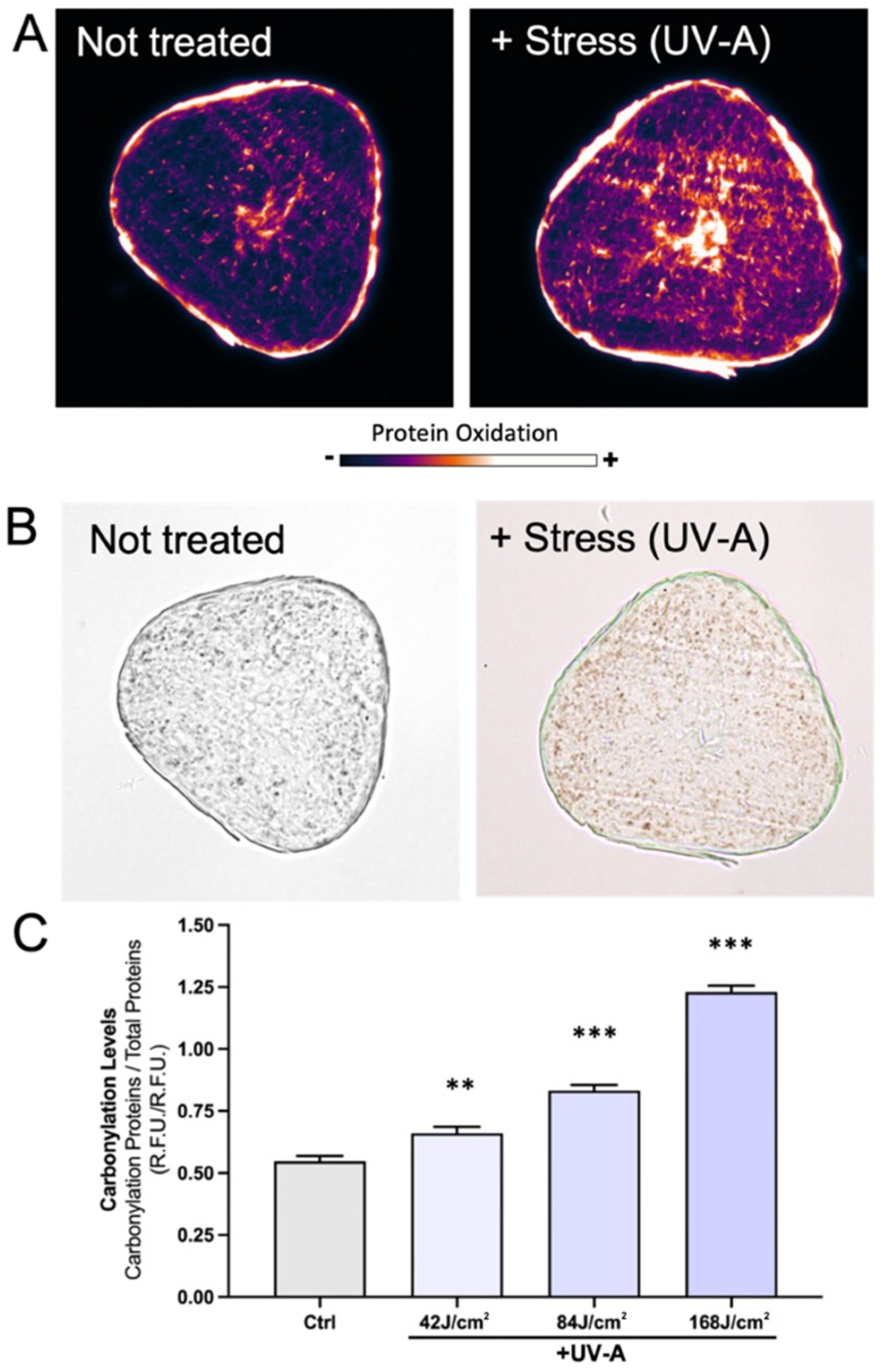
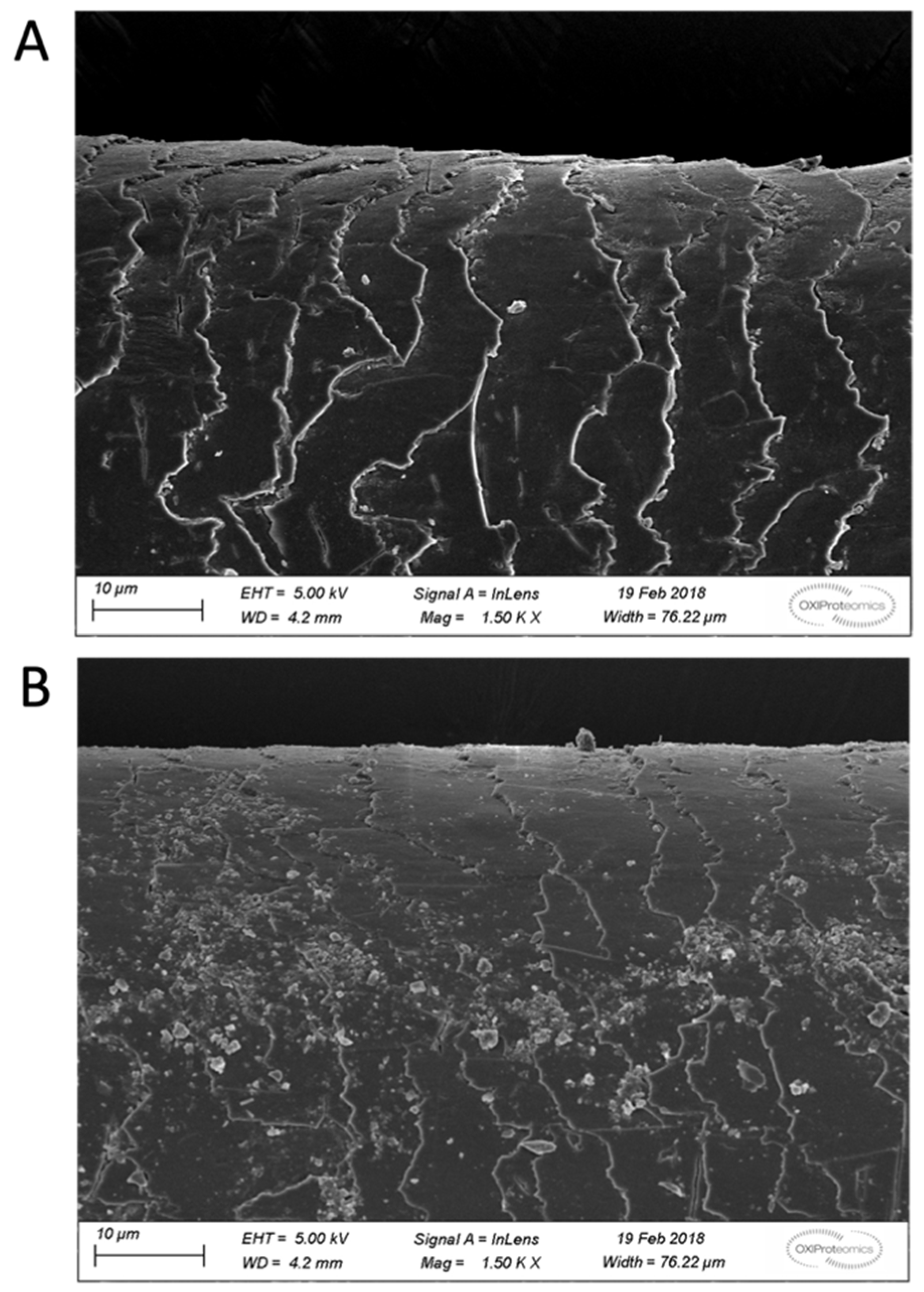
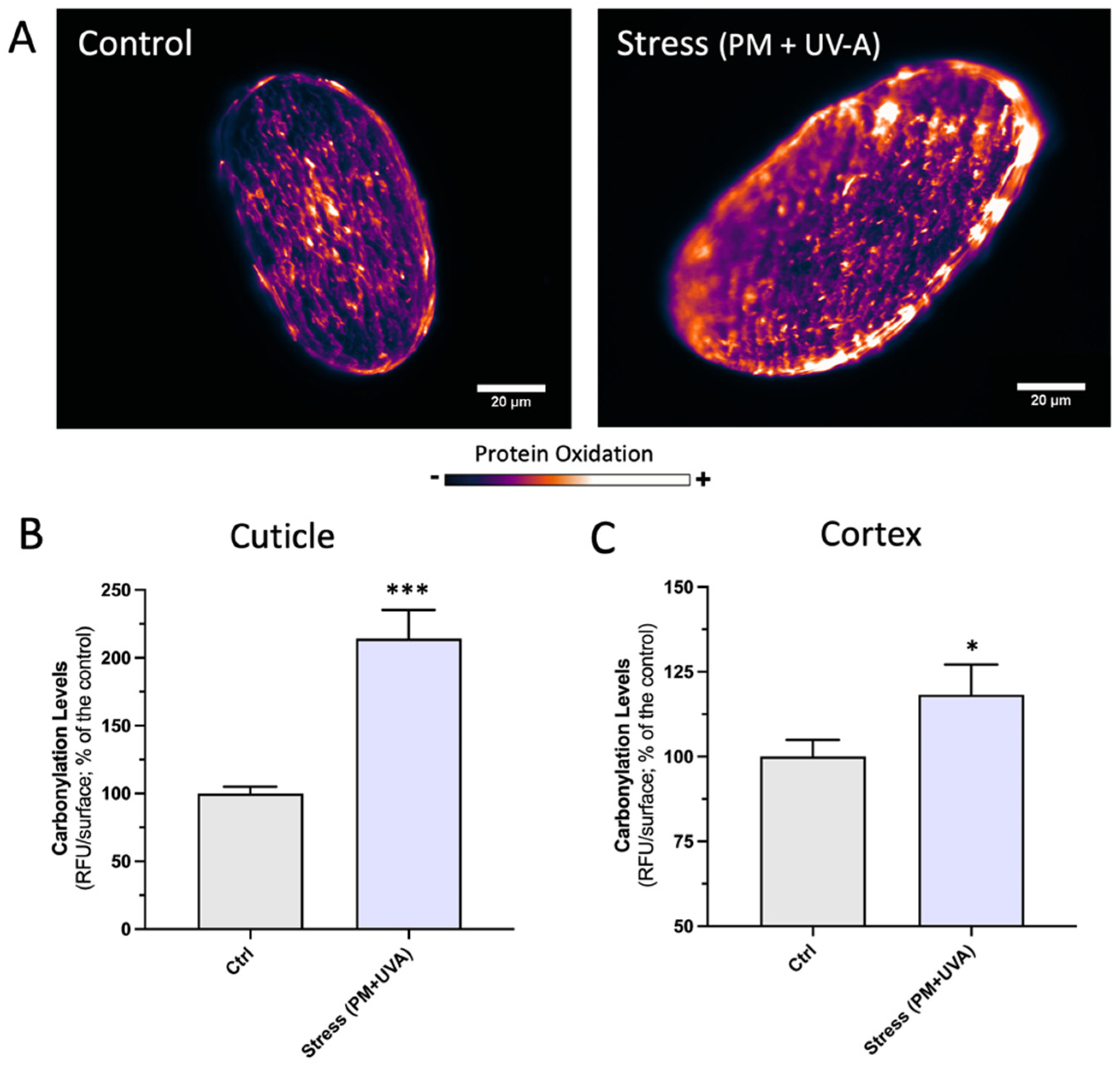
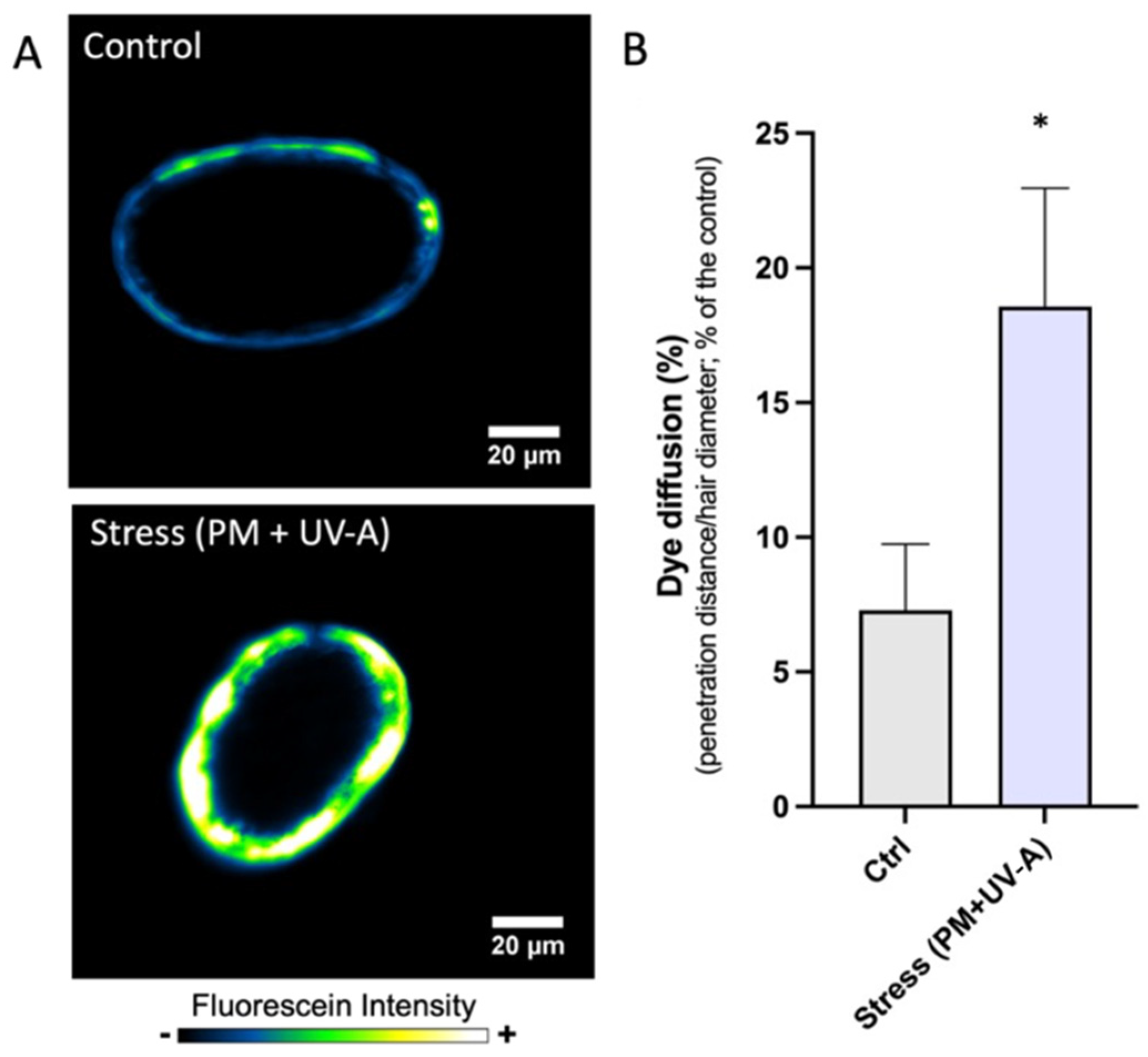
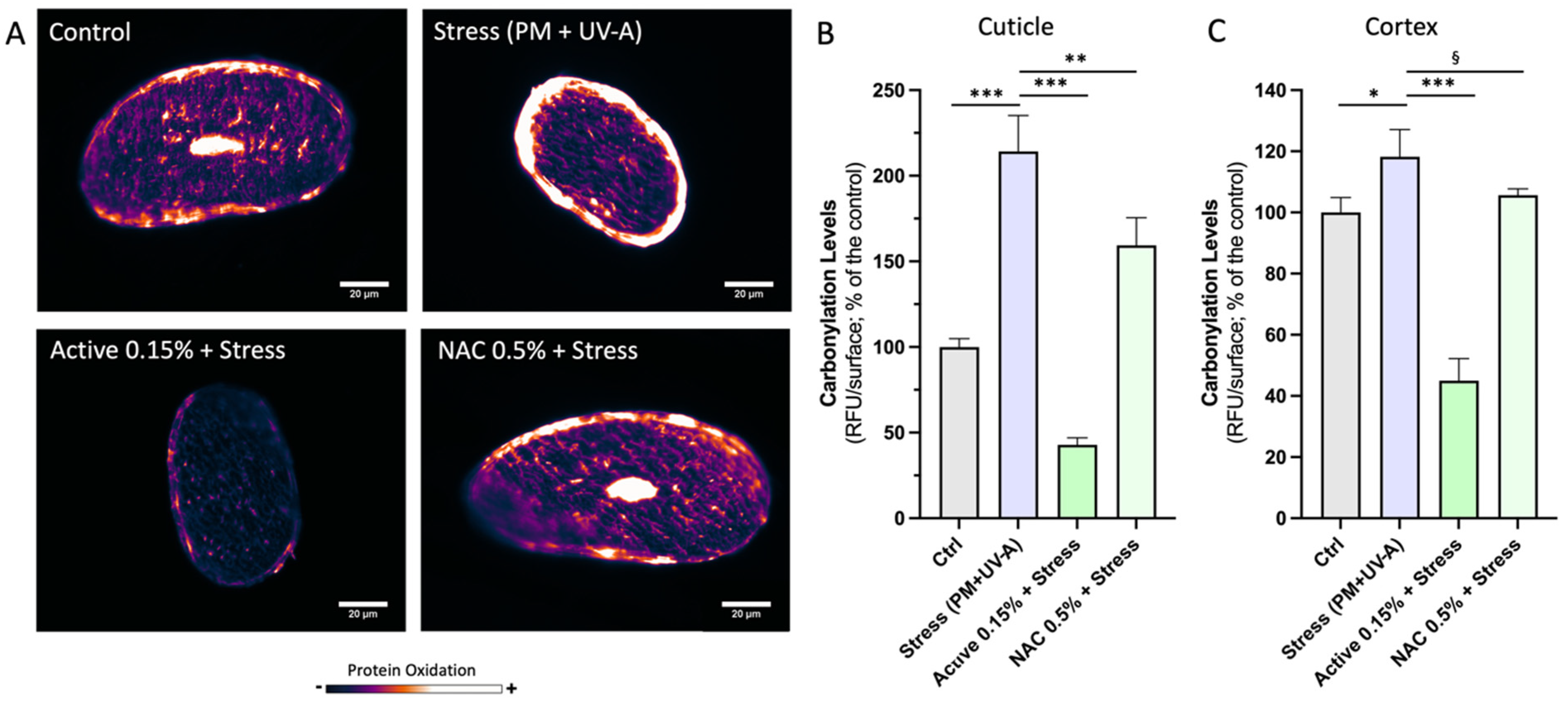
Publisher’s Note: MDPI stays neutral with regard to jurisdictional claims in published maps and institutional affiliations. |
© 2022 by the authors. Licensee MDPI, Basel, Switzerland. This article is an open access article distributed under the terms and conditions of the Creative Commons Attribution (CC BY) license (https://creativecommons.org/licenses/by/4.0/).
Share and Cite
Cavagnino, A.; Starck, A.; Bobier, A.; Baraibar, M.A. Protein Carbonylation as a Reliable Read-Out of Urban Pollution Damage/Protection of Hair Fibers. Cosmetics 2022, 9, 98. https://doi.org/10.3390/cosmetics9050098
Cavagnino A, Starck A, Bobier A, Baraibar MA. Protein Carbonylation as a Reliable Read-Out of Urban Pollution Damage/Protection of Hair Fibers. Cosmetics. 2022; 9(5):98. https://doi.org/10.3390/cosmetics9050098
Chicago/Turabian StyleCavagnino, Andrea, Arthur Starck, Anaïs Bobier, and Martin A. Baraibar. 2022. "Protein Carbonylation as a Reliable Read-Out of Urban Pollution Damage/Protection of Hair Fibers" Cosmetics 9, no. 5: 98. https://doi.org/10.3390/cosmetics9050098
APA StyleCavagnino, A., Starck, A., Bobier, A., & Baraibar, M. A. (2022). Protein Carbonylation as a Reliable Read-Out of Urban Pollution Damage/Protection of Hair Fibers. Cosmetics, 9(5), 98. https://doi.org/10.3390/cosmetics9050098






